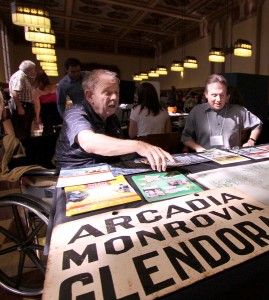Experts discuss, host exhibits about Los Angeles’ past
Visitors young and old gathered Saturday at Doheny Memorial Library to attend the seventh-annual Los Angeles Archives Bazaar to learn more about the history of Los Angeles and Southern California.

Bazaar: John Smatlak (right), chair of education and exhibits at Orange Empire Railway Museum, helps intrigued participants explore a dated map. – Arya Harsono | Daily Trojan
The event, organized by L.A. as Subject — a historical research alliance — and USC Libraries, brought together researchers, journalists and curious onlookers fascinated by the history of this vibrant area.
Attendees participated in a series of panels hosted by experts with a passion for learning and disseminating information about the history of the area. They also got the chance to tour an exhibition hall filled with numerous organizations that house historical collections, such as USC Digital Libraries and the Los Angeles City Archives.
Carol Wells, founding director of the Center for the Study of Political Graphics, discussed the importance posters have in depicting history by capturing moments at a point in time at the panel “CSI Los Angeles: Archival Case Study Investigations.”
“In collecting these posters, we try to collect the stories behind them … each one tells a story,” Wells said.
She showed off a series of posters from the 1960s, 1970s and 1980s that recall historical moments during these critical time periods, including some events that few people today even know existed.
A poster produced by the Black Panther Party, for instance, reveals how the political party, which many people consider separatist in nature, actually acted in collaboration with the Latino community during the 1970s.
Wells also noted that the growth of local print shops, which rivaled commercial shops, mushroomed during the 1960s and 1970s because commercial shops were loath to print politically radical posters.
“Local print shops in different cities started because you couldn’t get commercial print shops to print [politically inciting] posters,” she said.
Bailey Wilson, a senior majoring in narrative studies, said that the most interesting thing she learned from “CSI Los Angeles” was how posters reveal the extent to which white supremacy was grounded in the L.A. area in the 1960s and 1970s.
“I did not know that Southern California was such an epicenter for white supremacy, and I was shocked,” Wilson said. “I’m used to California being a much more open, liberal state in general.”
In addition to “CSI Los Angeles,” the event also featured a panel discussion about how Los Angeles became the worldwide center for car culture, thanks to drag races, drive-thrus and the 405 Freeway.
Nancy Fann, a junior majoring in chemical engineering, said she came to the Bazaar because she feels there is never too much to learn about history.
“On my own, I think I have quite an extensive [amount of knowledge about] L.A. history, amongst my peers, but I wouldn’t say I know as much as I should or as much as I want,” Fann said.
Though Fann noted that the Bazaar was “the perfect place” to learn about Southern Californian history, she wished more emphasis had been placed on a subject that fascinates her — architecture.
“[Old architecture] is one of the things that gets overlooked a lot,” Fann said. “Most people associate cities with more modern skylines, which personally for me are kind of boring. Some of the older buildings — they put in a lot more thought, a lot more creative energy.”
Wilson remarked how history is such a multifaceted subject.
“I would like to know some other ways in which they’re uncovering history and unraveling different things,” Wilson said. “[Wells] talked about how she learned through posters … but there’s more that history books can’t teach you.”
